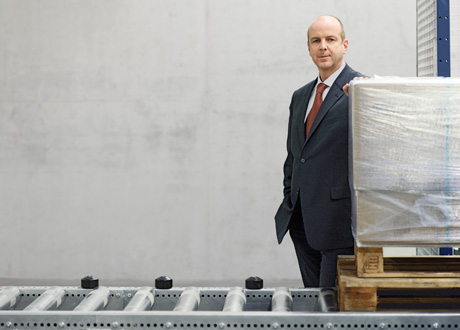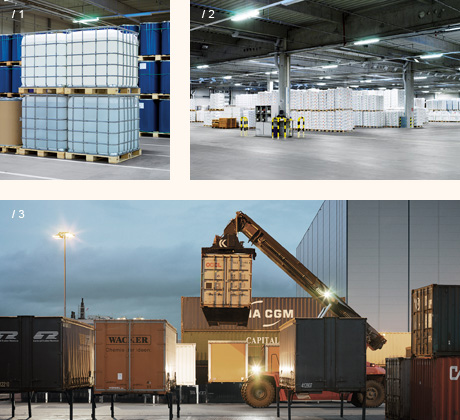How can logistics adapt to changes in ordering behavior, new product ranges, and a wide variety of transport options |
An insight into the modern logistics and distribution center. It has space for approximately 23,000 pallets. The integrated fire prevention system reduces the amount of oxygen in the air and ensures that there is no chance of a fire starting. |
WACKER has devised its new logistics and distribution center as a highly efficient and flexible system. |
|
|
It seems a little like the computer game Tetris in which players have to place differently-shaped blocks in such a way that unbroken rows are created. In the new logistics and distribution center (complementing an existing center) on the edge of the WACKER site in Burghausen, the employees fit pallets loaded with beige drums, compact pails, and brilliant white sacks into shipping containers and cargo trailers with absolute precision. They even out varying heights with chipboards, prop up the products with empty pallets, lash down the goods, and insert air cushions for protection. Although this takes a lot of time and effort, Dr. Thomas Bronnert can make a good case for it. “We regard logistics as a part of product quality,” explains the tall logistics manager, who joined the company 12 years ago. “First and foremost, the goods must arrive safely and in undamaged condition, but they must also make a good visual impression on the customer. When the pallet comes out of the container, this is often the customer’s first contact with our product.” |
First impressions count – as well as arriving undamaged, the goods should look appealing for the customers. |
|
The art of packaging is an everyday priority in the modern logistics and distribution center, which was expanded in 2008. “A chemical production site that evolved over a long period has become a logistics hub for the chemical industry,” declares Bronnert, who is proud of this achievement and the work of the approximately 250 logistics employees. The new momentum can be read from two simple figures. The rate of turnover, in other words the frequency with which the entire warehouse stock turns around, increased from 12 to 18 over the year. “The logistics and distribution center is faster and can adapt itself better to market developments.” The major modernization program was planned before the turn of the millennium. That was when the then CEO and present-day Chairman of the Supervisory Board, Dr. Peter-Alexander Wacker, had the idea of optimizing the processes in the plant. The company switched entirely to SAP and re-examined all of its processes. For the logistics area, this meant improving in-house and external transport. Since then, WACKER has increasingly shifted transportation within the plant from rail to road. “The tracks were very narrow, a lot of shunting had to be done, and it all took quite a long time,” remembers Bronnert as he looks from his unpretentious office’s large window onto the in-plant railroad line. In addition, the logistics specialists coordinated the in-plant inbound and outbound deliveries. In the old warehouse, the containers and trucks passed through the same gates. Today, the goods come from various parts of the plant by swap body, arriving at the new warehouse at 20 gates, from where they are consigned to the high-bay shelves by forklift. In a second area, the goods are ready for delivery. On the one side, huge trucks pull in at 18 gates. At the 12 gates on the other side, you’ll find the shipping containers that WACKER transports by train to the seaports in Bremerhaven and Hamburg once per working day. “This means that we have become substantially more effective,” confirms Bronnert as he observes a truck that the shipping company’s driver and a WACKER employee are in the process of loading. “We integrate the shipping companies into our work for safety reasons. This makes the collaboration more efficient,” Bronnert comments. “The throughput time of a truck from the time it enters the plant to the time it leaves, with loading in between, has been shortened considerably thanks to modern handling at the gates and process optimization in the warehouse. Today, we achieve throughput times of well under an hour.” |
Burghausen: a logistics hub. Throughput has increased considerably in recent years. |

|
Dr. Thomas Bronnert is head of logistics at WACKER in Burghausen. The 43-year-old father of two joined WACKER as a chemist immediately after acquiring his doctorate. |
|
The changed product range and the company’s robust growth also strongly influenced the logistics. Just a decade ago, WACKER was also transporting bulk freight such as caustic soda and salts for its (now sold) PVC operations in large tankers. The focus is now on specialty chemicals which are considerably smaller in volume. Despite this, WACKER – with over 700,000 metric tons in 2008 – almost reached the transport volume it had achieved in 2000. |
|
|
Most of the new products are stored on pallets in the high-bay warehouse, which is 3,000 square meters in area and 32 meters in height. These products have the advantage of being highly suitable for transportation in containers. This is why the company relies a great deal on rail transportation outside of the plant. It is more environmentally sound, more efficient, and – last but not least – more reliable. “We must have transferred an average of 18,000 truck journeys per year to rail,” mentions Bronnert while just 30 meters away, a locomotive is connecting to some freight cars. “We are loading around three times as many containers as we did in 1999 and are, thereby, ensuring one of the highest capacity-utilization rates on freight trains in Germany.” One-third of all WACKER products are loaded and unloaded in the two logistics centers at the Burghausen site with their 75 employees. Another third is shipped by road or rail directly from the site’s 42 production facilities, and the rest is bulk freight that goes to customers by tanker. This three-way division helped the logistics specialists determine the size of the logistics and distribution center in close cooperation with the individual WACKER plants on the site. Although every plant tries to accumulate as little warehouse stock as possible, it is impossible to operate with none at all. “For production-related reasons, we can operate some plants optimally only if their capacity is utilized to the full, for example with 100 metric tons of product,” clarifies Bronnert. “If a customer orders only 20 metric tons, the rest will go into the warehouse.” Similarly, the setting-up times of particular plants in the event of product changes make it necessary to stock products for short-notice orders. |
Environmentally friendly, cost-effective, and reliable – WACKER makes great use of railroad transportation. |
|
The logistics are planned with great flexibility as far as shifts, work load, and possible throughputs are concerned. Bronnert and his colleagues are, therefore, coping even with the current economic crisis, which is causing much shorter lead times for dispatch. “There was a time when several weeks were standard, but now many customers order at short notice according to requirements so that they don’t tie up so much capital,” Bronnert affirms. At the same time, this increases the number of orders, meaning added complexity for WACKER’s logistics staff. The logistics specialists at WACKER are well equipped for the future. Particularly since another major step is imminent. There are plans to construct a public container terminal in 2012. This new terminal will be opening up further possibilities of shifting traffic from road to rail – for WACKER as well as for local companies from the chemical industry and other branches. |
Flexibility is the key. As orders are placed at increasingly short notice, logistics become more and more complex. |

|
1 The finished products are packaged in a wide range of different shipping containers. Intermediate bulk containers hold 1,000 liters and are increasingly replacing pallets holding four 200-liter drums. This means that a larger quantity of product can be shipped on the same load unit. 2 The large block storage area is located between the loading areas for trucks and containers. This layout keeps distances short for maximum efficiency. 3 Every year, gantry cranes and reach stackers handle over 10,000 loaded containers in the terminal area. |